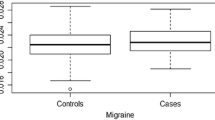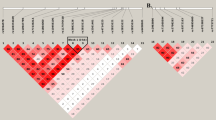Abstract
Migraine is a common neurological disease with a complex genetic aetiology. The disease affects ~12 % of the Caucasian population and females are three times more likely than males to be diagnosed. In an effort to identify loci involved in migraine susceptibility, we performed a pedigree-based genome-wide association study of the isolated population of Norfolk Island, which has a high prevalence of migraine. This unique population originates from a small number of British and Polynesian founders who are descendents of the Bounty mutiny and forms a very large multigenerational pedigree (Bellis et al.; Human Genetics, 124(5):543–5542, 2008). These population genetic features may facilitate disease gene mapping strategies (Peltonen et al.; Nat Rev Genet, 1(3):182–90, 2000. In this study, we identified a high heritability of migraine in the Norfolk Island population (h 2 = 0.53, P = 0.016). We performed a pedigree-based GWAS and utilised a statistical and pathological prioritisation approach to implicate a number of variants in migraine. An SNP located in the zinc finger protein 555 (ZNF555) gene (rs4807347) showed evidence of statistical association in our Norfolk Island pedigree (P = 9.6 × 10−6) as well as replication in a large independent and unrelated cohort with >500 migraineurs. In addition, we utilised a biological prioritisation to implicate four SNPs, in within the ADARB2 gene, two SNPs within the GRM7 gene and a single SNP in close proximity to a HTR7 gene. Association of SNPs within these neurotransmitter-related genes suggests a disrupted serotoninergic system that is perhaps specific to the Norfolk Island pedigree, but that might provide clues to understanding migraine more generally.
Similar content being viewed by others
References
Bellis C et al (2008) Linkage mapping of CVD risk traits in the isolated Norfolk Island population. Hum Genet 124(5):543–552
Peltonen L, Palotie A, Lange K (2000) Use of population isolates for mapping complex traits. Nat Rev Genet 1(3):182–190
ICHD-II (2004) International classification of headache disorders, 2nd edn. Cephalalgia 24(suppl 1): 1–160
Lipton RB, Bigal ME (2005) Migraine: epidemiology, impact, and risk factors for progression. Headache: The Journal of Head and Face Pain 45:S3–S13
Stewart WF et al (2006) Familial risk of migraine: variation by proband age at onset and headache severity. Neurology 66(3):344–348
Cologno D, Pascale AD, Manzoni GC (2003) Familial occurrence of migraine with aura in a population-based study. Headache: The Journal of Head and Face Pain 43(3):231–234
Mulder EJ et al (2003) Genetic and environmental influences on migraine: a twin study across six countries. Twin Research 6:422–431
Svensson DA et al (2003) Shared rearing environment in migraine: results from twins reared apart and twins reared together. Headache: The Journal of Head and Face Pain 43(3):235–244
De Fusco M et al (2003) Haploinsufficiency of ATP1A2 encoding the Na+/K + pump alpha2 subunit associated with familial hemiplegic migraine type 2. Nat Genet 33(2):192–196
Dichgans M et al (2005) Mutation in the neuronal voltage-gated sodium channel SCN1A in familial hemiplegic migraine. Lancet 366(9483):371–377
Ophoff RA et al (1996) Familial hemiplegic migraine and episodic ataxia type-2 are caused by mutations in the Ca2+ channel gene CACNL1A4. Cell 87(3):543–552
Lafreniere RG et al (2010) A dominant-negative mutation in the TRESK potassium channel is linked to familial migraine with aura. Nature Medicine 16:1157–1160
Pietrobon D (2007) Familial hemiplegic migraine. Neurotherapeutics 4(2):274–284
Anttila V et al (2010) Genome-wide association study of migraine implicates a common susceptibility variant on 8q22.1. Nat Genet 42:869–873
Macgregor S et al (2010) Legacy of mutiny on the Bounty: founder effect and admixture on Norfolk Island. Eur J Hum Genet 18:67–72
Hoare M (1999) Norfolk Island: a revised and enlarged history 1774–1998, 5th edn. Central Queensland University Press, Rockhampton, p 228 pages
Matthews SP (2001) Norfolk Island census of population and housing 7 August 2001—statistical report on characteristics of population and dwellings. Photopress International, Norfolk Island
Cox HC et al (2012) Heritability and genome-wide linkage analysis of migraine in the genetic isolate of Norfolk Island. Gene 494(1):119–123
Deprez L et al (2007) Familial occipitotemporal lobe epilepsy and migraine with visual aura: Linkage to chromosome 9q. Neurology 68(23):1995–2002
Ligthart L et al (2008) A genome-wide linkage scan provides evidence for both new and previously reported loci influencing common migraine. Am J Med Genet B: Neuropsychiatric Genetics 147B(7):1186–1195
Evans DM, Cardon LR (2004) Guidelines for genotyping in genomewide linkage studies: single-nucleotide-polymorphism maps versus microsatellite maps. Am J Hum Genet 75(4):687–692
John S et al (2004) Whole-genome scan, in a complex disease, using 11,245 single-nucleotide polymorphisms: comparison with microsatellites. Am J Hum Genet 75(1):54–64
Lipton RB et al (2007) Migraine prevalence, disease burden, and the need for preventive therapy. Neurology 68(5):343–349
Almasy L, Blangero J (1998) Multipoint quantitative-trait linkage analysis in general pedigrees. Am J Hum Genet 62(5):1198–1211
Igl W et al (2010) Modeling of environmental effects in genome-wide association studies identifies SLC2A2 and HP as novel loci influencing serum cholesterol levels. PLoS Genet 6(1):e1000798
Mostafavi S et al (2008) GeneMANIA: a real-time multiple association network integration algorithm for predicting gene function. Genome Biol 9(S4). doi:10.1186/gb-2008-9-s1-s4
Chanock SJ et al (2007) Replicating genotype–phenotype associations. Nature 447:655–660
Schürks M, Buring JE, Kurth T (2009) Agreement of self-reported migraine with ICHD-II criteria in the Women's Health Study. Cephalalgia 29(10):1086–1090
Kurth T et al (2006) Migraine and risk of cardiovascular disease in women. JAMA 296(3):283–291
Ridker PM et al (2008) Rationale, design, and methodology of the Women' Genome Health Study: a genome-wide association study of more than 25,000 initially healthy American women. Clin Chem 54(2):249–255
Zee RYL et al (2007) Homocysteine, 5,10-Methylenetetrahydrofolate Reductase 677 C-T Polymorphism, Nutrient Intake, and Incident Cardiovascular Disease in 24 968 Initially Healthy Women. Clinical 53(5):845–851
Laity JH, Lee BM, Wright PE (2001) Zinc finger proteins: new insights into structural and functional diversity. Curr Opin Struct Biol 11:39–46
Urbach A, Bruehl C, Witte OW (2006) Microarray-based long-term detection of genes differentially expressed after cortical spreading depression. Eur J Neurosci 24:841–856
Puri V et al (2005) Ovarian steroids regulate neuropeptides in the trigeminal ganglion. Neuropeptides 39(4):409–417
Maas S et al (2006) A-to-I RNA editing and human disease. RNA Biol 3(1):1–9
Hanna GL et al (2007) Evidence for a susceptibility locus on chromosome 10p15 in early-onset obsessive-compulsive disorder. Biol Psychiatr 62(8):856–862
Bard JA et al (1993) Cloning of a novel human serotonin recepto (r5-HT7) positively linked to adenylate cyclase. J Biol Chem 268(31):23422–23426
Vanhoenacker P, Haegeman G, Leysen JE (2000) 5-HT7 receptors: current knowledge and future prospects. Trends Pharmacol Sci 21:70–77
Hamel E (2007) Serotonin and migraine: biology and clinical implications. Cephalalgia 27(11):1293–1300
Shields KG, Goadsby PJ (2006) Serotonin receptors modulate trigeminovascular responses in ventroposteromedial nucleus of thalamus: a migraine target? Neurobiol Dis 23(3):491–501
Corominas R et al (2009) Association study of the serotoninergic system in migraine in the Spanish population. Am J Med Genet B: Neuropsychiatric Genetics 153B(1):177–184
Acknowledgments
This research was supported by funding from the National Health and Medical Research Council (NHMRC) of Australia, from a Medical Bioinformatics Genomics Proteomics Program grant as well as an Australian DEST International Science Linkages grant. Hannah Cox was supported by a NHMRC Biomedical Postgraduate Scholarship and Rod Lea is partially supported by a Corbett Research Fellowship. The SOLAR statistical genetics computer package is supported by a grant from the US National Institute of Mental Health (MH059490). Lastly, we extend our appreciation to the Norfolk Islanders who volunteered for this study.
Author information
Authors and Affiliations
Corresponding author
Electronic supplementary material
Below is the link to the electronic supplementary material.
Supplementary Fig. 1
Manhattan Plot of autosomal genome-wide associations for migraine in the Norfolk Island pedigree. (DOC 73 kb)
Supplementary Fig. 2
(PPTX 142 kb)
Supplementary Table 1
Summary of the top 0.05 % of SNPs (n = 172) detected in the Norfolk study (DOC 322 kb) (DOC 322 kb)
Supplementary Table 2
Results of replication study in WGHS cohort. (DOCX 78 kb)
ESM 2
(DOCX 166 kb)
Rights and permissions
About this article
Cite this article
Cox, H.C., Lea, R.A., Bellis, C. et al. A genome-wide analysis of 'Bounty' descendants implicates several novel variants in migraine susceptibility. Neurogenetics 13, 261–266 (2012). https://doi.org/10.1007/s10048-012-0325-x
Received:
Accepted:
Published:
Issue Date:
DOI: https://doi.org/10.1007/s10048-012-0325-x




